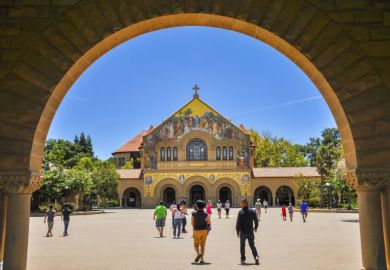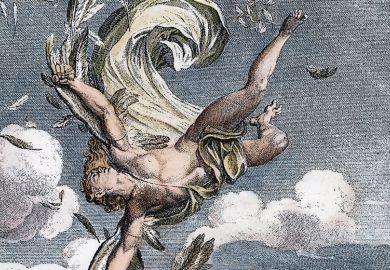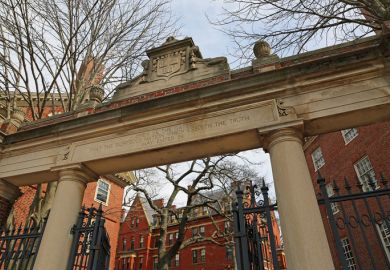This summer shone a light on a neglected barometer of universities’ fitness as preparers of young Americans for both life and career.
Within a few weeks in July, student journalists were responsible for two nationally and internationally important stories. An article in Northwestern University’s Daily Northwestern led to the firing of the university’s most celebrated football coach amid allegations of hazing. Then Stanford president Marc Tessier-Lavigne resigned following an investigation into research misconduct that was sparked by an article in The Stanford Daily published last November.
Unlike Northwestern, home to the nationally distinguished Medill College of Journalism, Stanford has no college or department of journalism. The Daily’s nationally praised reporting was conducted by Theo Baker, an 18-year-old humanities and social science major between his first and second years – albeit one with two nationally known journalists as parents.
Harvard University also lacks a journalism programme, yet The Crimson has a lengthy history of exposing both administrative and faculty malfeasance. Most recently, it received well-deserved plaudits for persistent reporting on distinguished male academics’ not-quite-secret histories of sexual assault of female graduate students.
At Northwestern, the suspension of Pat Fitzgerald prompted students to probe further into the hazing allegations. By conducting old-fashioned investigative reporting, following each lead to the next, they uncovered years of allegations that implicated both players and coaches, including coerced sexual assaults on younger players by masked older students in dark locker rooms.
Their story quickly became national news, shattering the calm veneer attempted by the president’s matter-of-fact announcement of a suspension and forcing the coach’s dismissal – over the wishes of influential persons on and off campus. And the football scandal quickly led to the exposure and firing of Northwestern’s baseball coach for bullying. At least 10 former or present student athletes are suing the university.
And while problems with Tessier-Levigne’s publications were well known in the field, Baker’s reporting prompted Stanford to mount an investigation that recommended several retractions. The former Genentech executive’s own responsibility for the altered imagery remains in debate, but he evidently did not supervise his lab or its publications properly, making his presidency untenable.
These examples of exposés by student journalists are not unique, but they are exceptional. Does that not seem odd given the wide range of scandals that we might expect student journalists to get their teeth into, from the premature departures of senior administrators under various clouds to egregious behaviour at fraternities and on sports teams?
That, in turn, raises the question of whether campus power structures are affording student newspapers and their reporters the freedom of speech and inquiry to pursue stories wherever they take them – and to take responsibility for their publication.
In fact, we already know the answer to those questions. Each triumph in student journalism is achieved despite widespread institutional obstruction, control, and censorship of student journalists.
The Stanford Daily published despite legal threats from Tessier-Levigne. And numerous cases of firings or disciplining of faculty advisors of student publications are listed in the American Association of University Professors’ 2016 report on “Threats to the Independence of Student Media”.
At my university, Ohio State University, former president E. Gordon Gee personally threatened to fire the editor of its student newspaper, The Lantern, for criticising him. The editor, now a national education reporter for the Associated Press, stood firm. Gee backed down. The student’s parents, who were medical school faculty, were proud of him.
Since that time, the independence of The Lantern has ebbed and flowed according to changes in its advisers, hired and fired by the School of Communications, reputedly under central administrative dictates. So too has my personal cooperation with editors and reporters. The journalists are currently forbidden to even acknowledge an email, with leads and evidence, from me. In other words, they are banned from communicating with a faculty member who has a long history of collegial and professorial cooperation with student publications at his own and other institutions. Instead, they appear to be obliged to churn out an endless series of inconsequential stories about football.
The contradictions to universities’ touted intellectual and free speech commitments – rather, the slogans – are massive. They echo across campuses and throughout society and culture. If, as the Washington Post slogan has it, democracy dies in darkness, universities are the first institutions that ought to be fighting to keep the lights on.
Harvey J. Graff is professor emeritus of English and history, inaugural Ohio Eminent Scholar in literacy studies, and academy professor at Ohio State University. He is now writing Reconstructing the ‘Uni-versity’ from the Ashes of the ‘Multi- and Mega-versity’.
Register to continue
Why register?
- Registration is free and only takes a moment
- Once registered, you can read 3 articles a month
- Sign up for our newsletter
Subscribe
Or subscribe for unlimited access to:
- Unlimited access to news, views, insights & reviews
- Digital editions
- Digital access to THE’s university and college rankings analysis
Already registered or a current subscriber?








